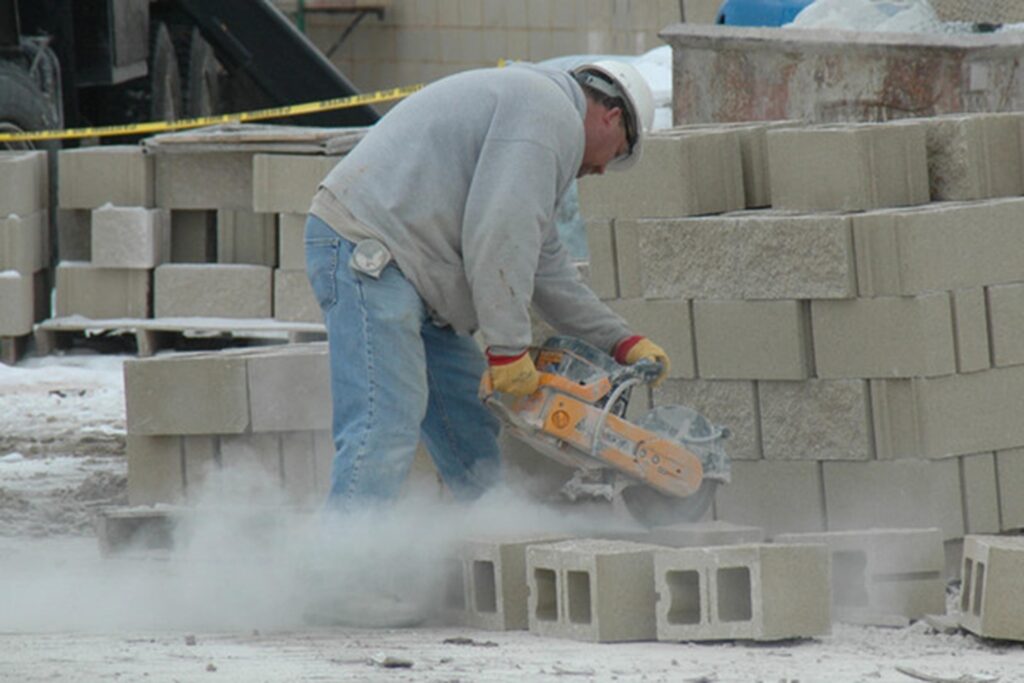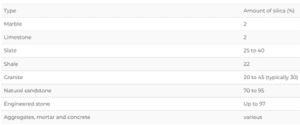Crystalline Silica and Silicosis – WHS Guide
 Crystalline silica (silica) is a component in sand, concrete, stone, and mortar. Its usage varies across multiple products, such as composite stone for fabricating kitchen and bricks, tiles, plastics, and bathroom benchtops. When workers cut, saw, crush, drill, polish, or grind products containing silica, dust particles are tiny enough to lodge deep in the human lungs and cause illness or diseases, including silicosis.
Crystalline silica (silica) is a component in sand, concrete, stone, and mortar. Its usage varies across multiple products, such as composite stone for fabricating kitchen and bricks, tiles, plastics, and bathroom benchtops. When workers cut, saw, crush, drill, polish, or grind products containing silica, dust particles are tiny enough to lodge deep in the human lungs and cause illness or diseases, including silicosis.
What is crystalline silica?
Crystalline silica is are the forms of silica that form respirable particles and are thus a WHS issue in the workplace. It is a natural mineral that forms the major component of most rocks and soils. Silicon dioxide is in two forms non-crystalline and crystalline. Quartz (CAS 14808-60-7) is the most common type of crystalline silica.
Different types of rock and their products can contain different amounts of silica, for example:

What is silica dust?
Silica dust generation is typical in workplaces with mechanical processes like grinding, sawing, crushing, cutting, drilling, and polishing natural stone or manufactured products containing silica. Some dust particles are tiny, not easily visible, and are known as respirable particles.
Respirable silica dust particles are tiny and dangerous as they can penetrate the lungs and cause irreversible lung damage. However, the non-crystalline or amorphous forms of silica are safer and do not cause this kind of lung damage.
Which workers are at risk?
Silica is an abundant mineral and has applications in many products across various industries. Crystalline silica is dangerous to health when its dust gets generated and becomes airborne and leading to inhalation by workers.
Some examples of work activities generating respirable silica dust particles are:
- earth moving, excavation, and drilling plant operations.
- stone and clay processing machine operations
- paving and surfacing
- mining, quarrying, and mineral ore treating processes
- tunneling
- during installation or fabrication of composite (engineered or manufactured) stone countertops
- labour in construction activities.
- cutting brick, concrete or stones using dry methods.
- abrasive blasting (blasting agent must not contain over 1 per cent of crystalline silica)
- chiselling, angle grinding, jackhammering and masonry or concrete.
- hydraulic fracturing of gas and oil wells,
- pottery-making.
- foundry casting
What health problems does silica dust cause?
Exposure to silica dust generally results in health problems associated with the lungs and respiratory tract. Exposed workers may develop no symptoms or they could develop the following:
- acute silicosis
- chronic bronchitis
- emphysema
- lung cancer
Workers can also develop severe inflammation and an outpouring of protein into the lungs, after several years this can lead to scarring of the lung tissue and chronic silicosis. Workers who develop these conditions suffer for decades and are often unable to work or perform other activities of daily living.
How do control the risk of silicosis?
As per the model WHS Regulations, PCBUs have responsibilities to manage health risks and safety while using, handling, generating and storing hazardous chemicals like silica. PCBUs must ensure the workplace exposure standard for crystalline silica does not get exceeded. They should also ensure providing health monitoring to workers.
PCBUs can manage worker exposures to silica and its risks. They can select and implement measures using the hierarchy of controls:
- Elimination of the risk altogether, although this is likely not practicable
- Substitution of silica products to other products with a lower percentage of silica.
- Isolation of the hazard – Use principles of safe work design. Designate separate areas for tasks that generate dust. Use appropriate worker positioning during these tasks, using enclosures and automation to conduct dust-generating tasks.
- Implement engineering controls to minimise the risk of exposure to generated dust. (for example, water suppression (wet cutting), local exhaust ventilation, or using tools with dust collection attachments.
- should a risk remain; administrative controls, including good housekeeping policies, shift rotations and modifying cutting sequences?
- should a risk remain; personal protective equipment, including appropriate respiratory equipment (generally a minimum of a P2 efficiency half-face respirator) and work clothing that does not collect dust.
More than one control will usually be required to protect workers adequately.
The workplace exposure standard
The workplace exposure standard that must not get exceeded for respirable crystalline silica (silica dust) is 0.05 mg/m3 (eight-hour time-weighted average).
PCBUs should ensure worker exposure to silica dust is as low as reasonably practicable. Conducting air monitoring exercises is helpful if there is any uncertainty that the exposure standards are met and not being exceeded or if finding out if a worker’s health is at risk.
Use the silica dust workplace checklist to know more about the changes to the WES for silica dust and manage the difference in your particular workplace.
Health monitoring for workers exposed to crystalline silica
As per WHS Regulations model, PCBUs must provide health monitoring for workers if they carry out ongoing work handling, generating, or storing crystalline silica. It applies in case of significant risk to the worker’s health due to exposure to silica.
The crystalline silica’s minimum health monitoring requirements are:
- Collection of medical, occupational, and demographic history.
- Personal exposure records.
- Questionnaire on standardised respiratory.
- Standardised respiratory function tests, for example – FEV1, FVC and FEV1/FVC, and
- Chest X-Ray full PA view (baseline and high-risk workers only).
You can find further information about the duties of health monitoring here.
